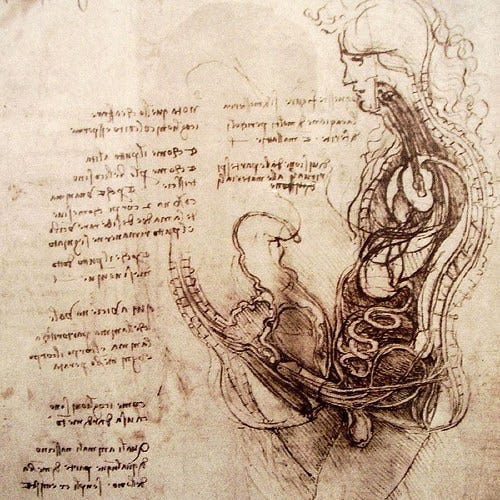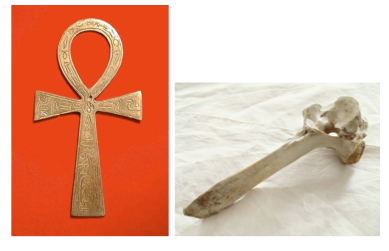Here is an excerpt from my talk at KU on the culture history of wet dreams.
Prehistory is dark, but in Sumer we have cuneiform clay tablets, the beginning of records, stories, ideas about semen, and thus about wet dreams. We find Enki, the creator God, lifting up his penis and ejaculating the Tigris river into the landscapes that gives birth to civilization. The ‘water’ mixes with dirt, and the first humans are made out of clay. Semen here is understood as fertilizing water, but water isn’t necessarily just a good thing. Not enough and one dies, too much and one dies, and water is associated with rot, urine, and foul smells. We know that wet things decay, whereas dry things stay clean.
There is a story of Enki getting sick from eating leaves made from his “spilled waters.” He gets pregnant with beings and almost dies because he doesn’t have a hole, so he can’t give birth. But the goddess, Innana, takes pity on poor Enki. She takes the babies from his belly and delivers them herself. She saves his life, again.
So we see in Sumer that semen is related to water, and we are also beginning to see semen turn into a kind of harmful substance or poison. Sumerian culture was no doubt influential, but Egypt is when these cultural forms really get set in stone.
Egyptian Wet Dreams
Egyptian culture flourished relatively unchanged for three thousand years, longer than any other culture in recorded history, much longer than Greece, albeit not nearly as long as our prehistoric structuring, but it’s still foundational. We can say that the cultural habits, or ‘habitus,’ the Egyptians laid down in history are still present today. Camille Paglia argues in Sexual Personae that our current sense of beauty and fashion — our eye-liner, make-up, dresses and metrosexuality — all of it represents people still living out the aesthetic tastes of Pharaoh. Maybe modern visual culture is the slow development of one of Pharoh’s wet dreams.
Egyptian mythology, just like Abrahamic, Mayan, and Japanese Shinto mythology, places semen and orgasm at the original metaphor for Genesis. Atum, the Egyptian creator, masturbates and then ejaculates the universe. The Mayans named their creator Itzanmaaj, which means “one who does itz,” and itz refers to ‘semen, milk, and other magical fluids.’ In Japan, Izanagi ejaculates the world from his ‘jeweled spear’ and then feeds beings life-force through his petrified semen rice, not unlike the way Yahweh feeds his people white sticky manna in the desert. In the Judeo-Christian version of Genesis, Yahweh, like Atum, gives rise to the universe all by himself and in a state of bliss. If we look at this myth as embodied, was it the Father’s tears or was it his semen that “gave birth” to the universe? It was probably his semen, although there is a version of the Egyptian story where Atum ejaculates into his mouth, spits out time and space, and then cries beings into the universe. I am reminded of that opening scene from the movie Shortbus where the main character is filming himself masturbating as a kind of suicide note. He ejaculates into his own mouth and then cries.
Thomas Hare, in ReMembering Osiris, says this about the Egyptian version, but it can apply to the others: “The phallus and its seminal trace exist then in a nexus of associations exemplifying, supporting, and extending the power of the father, on the one hand, and promulgating violence, pollution, and danger, on the other.”
The Eye of Horus
Semen plays an incredibly important role in Egyptian symbolism. For example, the Eye of Horus, if you read the Contendings of Horus and Set, is Horus’s semen that appears on Set’s forehead after they have sex, thus nullifying Set's right to be King of Egypt. Who knows this story?
Probably part political satire, part erotic poem, and part origin myth, the Contendings of Horus and Set begins with the death of Osiris — killed by his brother, Scar, I mean Set. There is a court battle between Set and Horus, Osiris’s son and reincarnation, about who gets to inherit Egypt. The Enead, ancestors, call for a break, and tell the uncle and nephew to stop fighting and to meet back in court again in the morning. Set invites Horus to his house and that night the two end up having sex! But, right before Set cums in Horus’s ass, Horus pulls out Set’s cock and holds it in his hand. Set unknowingly ejaculates into Horus’s fist. In the morning, Set leaves all happy and heads to the garden. Horus takes his uncle’s semen to his mother/wife, Isis, who quickly cuts off the defiled hand and feeds it to a fish that swims away deep into the river (an important detail). Isis then jerks off her husband/son, collects his semen, and she goes to the garden and secretly wipes it on Set’s favorite lettuce, which he carelessly eats for breakfast.
Later that very morning, at court, Set announces to everyone that he has new information: “I had sex with Horus last night. He is therefore emasculated and has no right to the throne.” Everyone looks to Horus who just laughs and says, “lies.”
Set: “No, no! I can prove it! Call forth my semen and it will come out of Horus’s head [where it was believed all semen is stored].” They call out for it, but the semen doesn’t come out of Horus’s head; it comes out of a fish suddenly seen sailing through the air from out of the river! Everyone laughs (because it implies that Set fucked a fish last night). Horus then says that the opposite it actually the case. “The truth is that I fucked my uncle Set. Call out to my semen and it will appear right where it should.” They call it forth, and the semen sure enough appears as a shiny drop in the center of uncle Set’s forehead. Suddenly, from out of nowhere, Thoth grabs Horus’s semen, slaps it onto his own head, and crowns himself King of Egypt!
It’s interesting how the anointing of oil on the head will be picked up by the Hebrews, who will call the holy oil, ‘shemen.’
This myth belongs to the oldest extended body of writing in the world, and already we see the idea that ejaculating into the wrong place, at the wrong time, is dangerous. And, I might add, we also see the beginning of the ‘contaminated food’ or ‘secret sauce’ theme of urban legends (like the ‘angry restaurant employee,’ or the ‘fraternity cream-filled donut prank.’) Urban legends, like myths, are believed to express deep cultural anxieties. You can read these semen-filled urban legends at snopes.com.
So, even though in Egypt we can say semen finally becomes filled with heredity, and therefore it becomes a symbol for men and masculinity, and even though its oily materiality is pretty much totally harmless if touched or eaten, semen is also marked as a kind of poison, one that dirties and defiles anything it touches.
This association is quite literal, actually. The Egyptian word mtwt[pronounced ‘mahtoot’] means both semen and venom. Martin Bernal (2006), Cornel Historian, in volume three of Black Athena, shows how mtwt in Egyptian means “semen, seed, progeny, the Nile…but also secreted materials from snakes and scorpions.” He thinks this may be because mtwt can be read mwtt, which resembles mut, the Afroasiatic word for “man,” and mut comes from mawut, meaning “to die.” There are a few other reasons I think.
It could be that semen is venom because semen is life and life is death (there is a kind of Buddhistic “life is suffering” logic going on here), but also because semen was believed to come from the spine, and there is a visual punning between the penis and a snake — which is essentially a living spinal column whose head looks like the glans, and whose milk/spit is dangerous.
Snakes
There are some early Christian sects that also associated semen with snakes, the spine, and with spinal fluid. The Peretae gnostics, for example, who flourished in the third-sixth century, had a great embodied cosmology where God the Father is the brain, His Son is the serpentine spinal column, and the Holy Spirit is the seminal spinal fluid, fed to the body from the Father via the Son. This doctrine was associated with other gnostic doctrines that speculated on the snake-like nature of the spinal column, which carried semen, or liquid consciousness/liquid eyes, from the brain to the genitals and back again. The spine thus performed the same role as Jesus, linking the Father with the world of matter. It’s interesting that Jesus is also cast in gnostic books like the Apocraphon of John as the serpent snake sent by God into the Garden of Eden.
Plato also characterized semen as “a soft flow from the spine”; and Leonardo de Vinci rendered semen coming from the spine in his 1493 drawing, “The Copulation,” which is interesting because he had the cadaver right in front of him, but his eyes must have been clouded by his culture.
The Garba Upanishad, an important Indian Vedic text, puts this early view of the body thus: “From food blood is born; from blood, flesh; from flesh, fat; from fat, bone; from bone, marrow; from marrow, semen.” We see how semen was believed to be the end of digestion, the clarified blood, or ghee of the person. We read in Gordan and Schwabe (The Quick and the Dead, 2004)that some Egyptian texts also show a close relationship between the backbone, life, and one’s ability to survive after death. The white bones of a bull remain on the altar after the fire destroys the pink flesh. This may be one reason why the ankh, the symbol for eternal life, is shaped like a bull’s thoracic vertebra, and why Eve, in the most popular Hebrew version of Genesis, was created from a thoracic bone. This idea that sperm comes from bone marrow is interesting considering how scientists in 2007 learned how to make sperm from bone marrow. Maybe the ancient Egyptian idea wasn’t just ignorant medicine and wishful thinking. Maybe it was a vision of the future.
Egyptian semen/venom ‘mahtoot’ finds its way into the Jewish midrash, that collection of folk stories meant to supplement the priest’s texts, and one describes Eve as being created not from Adam’s rib but from Adam’s tail, which “ended in a sting.” It doesn’t help that scorpion venom physically resembles semen.
For more semen history, please visit my series on Medium:
Christian wet dreams: when semen in sin.
Buddhist and Hindu wet dreams: when semen is mind.
Jewish wet dreams: Lilith's revenge!
Prehistoric wet dreams: when semen is milk
Christian wet dreams: when semen in sin.
Buddhist and Hindu wet dreams: when semen is mind.
Jewish wet dreams: Lilith's revenge!
Prehistoric wet dreams: when semen is milk



